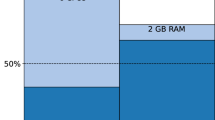Abstract
The resource fair allocation is very important for the most systems. This paper focuses on the resource allocation in a big data system. This system has the characteristics of multiple resources owning and heterogeneous resource demanding. Firstly, a basic allocation scheme is proposed. Some allocation properties are introduced including sharing incentive, strategy proofness, envy-freeness, Pareto optimality, resource efficiency, single-layer multi-resource fairness, multi-layer single-resource fairness. Secondly, a single layer dominant and max–min fair allocation (SDMMF) is proposed. The basic idea is that the resources are firstly allocated using dominant resource fairness scheme. If some resources are not fully allocated, using max–min fairness scheme allocate the surplus ones. The SDMMF is theoretically proved satisfying all the hierarchical resource allocation properties. Thirdly, a Multi-layer resource allocation scheme, namely multi-layer dominant and max–min fair allocation (MDMMF) is proposed. The basic idea is that a multi-layer resource demand hierarchy can be divided into a series of single layer resource demand. So a resource demand vector can be built in the hierarchy from down to top. Then, the resource allocation of first layer is calculated using SDMMF allocation. The result of such allocation is further allocating in the third layer. Recursively do the MDMMF allocation until the bottom layer nodes obtain resource allocation shares. Lastly, The MDMMF is also theoretically proved satisfying all the hierarchical resource allocation properties.






Similar content being viewed by others
References
Amaldi, E., Capone, A., Coniglio, S., & Gianoli, L. G. (2013). Network optimization problems subject to max–min fair flow allocation. IEEE Communications Letters (ICL), 17(7), 1463–1466.
Kim, Y., & Sichitiu, M. L. (2011). Optimal max–min fair resource allocation in multihop relay-enhanced WiMAX networks. IEEE Transactions on Vehicular Technology (TVT), 60(8), 3907–3918.
Karachontzitis, S., Timotheou, S., Krikidis, I., & Berberidis, K. (2015). Security-aware max–min resource allocation in multiuser OFDMA downlink. IEEE Transactions on Information Forensics and Security (TIFS), 10(3), 529–542.
Mankar, P. D., Das, G., & Pathak, S. S. (2015). A novel proportionally fair spectrum allocation in two tiered cellular networks. IEEE Communications Letters (ICL), 19(4), 629–632.
Illanko, K., Anpalagan, A., Hossain, E., & Androutsos, D. (2014). On the power allocation problem in the Gaussian interference channel with proportional rate constraints. IEEE Transactions on Wireless Communications (TWC), 13(2), 1101–1115.
Hou, I. H., & Gupta, P. (2014). Proportionally fair distributed resource allocation in multiband wireless systems. IEEE/ACM Transactions on Networking (TON), 22(6), 1819–1830.
Chandra, A., & Shenoy, P. J. (2008). Hierarchical scheduling for symmetric multiprocessors. IEEE Transactions on Parallel Distributed Systems (TPDS), 19(3), 418–431.
Goyal, P., Guo, X., & Vin, HM. (1996). A hierarchical CPU scheduler for multimedia operating systems. In Proceedings of OSDI (pp. 107–121).
Bennett, J. C. R., & Zhang, H. (1997). Hierarchical packet fair queueing algorithms. IEEE/ACM Transactions on Networking (TON), 5(5), 675–689.
Isard, M., Prabhakaran, V., Currey, J., Wieder, U., Talwar, K., & Goldberg, A. (2009). Quincy: Fair scheduling for distributed computing clusters. In SOSP’09.
Ghodsi, A., Zaharia M., Hindman, B., Konwinski, A., Shenker, S., & Stoica, I. (2011). Dominant resource fairness: Fair allocation of multiple resource types. NSDI.
Dolev, D., Feitelson, D., Halpern, J., Kupferman, R., & Linial, N. (2012). No justified complaints: On fair sharing of multiple resources. In Proceedings of ACM ITCS.
Wang, W., Li, B., & Liang, B. (2014). Dominant resource fairness in cloud computing systems with heterogeneous servers. In Proceedings of INFOCOM 2014.
Wang, W., Liang, B., & Li, B. (2015). Multi-resource fair allocation in heterogeneous cloud computing systems. IEEE Transactions on Parallel and Distributed Systems, 26(10), 2822–2835.
Ghodsi, A., Sekar, V., Zaharia, M., Stoica, I. (2012). Multi-resource fair queueing for packet processing. In Proceedings of SIGCOMM (pp. 1–12).
Zaharia, M., Borthakur, D., Sen Sarma, J., Elmeleegy, K., Shenker, S., & Stoica, I. (2010). Delay scheduling: A simple technique for achieving locality and fairness in cluster scheduling (Vol. 10). EuroSys: Prague.
Jaffe, J. M. (1980). A decentralized optimal multiple-user flow control algorithm. In Proceedings of Fifth International Conference on Computer Communication.
Jaffe, J. M. (1981). Bottleneck flow control. IEEE Transactions on Communications, 29(7), 954–962.
Max–min fairness, http://en.wikipedia.org/wiki/Max-min_fairness.
Demers, A., Keshav, S., & Shenker, S. (1989). Analysis and simulation of a fair queueing algorithm. In SIGCOMM’89, (pp. 1–12). New York, NY: ACM.
Waldspurger, C. A. (1995). Lottery and stride scheduling: Flexible proportional share resource management. Ph.D. thesis, MIT, Laboratory of Computer Science, MIT/LCS/TR-667.
Waldspurger, C. A., & Weihl, W. E. (1994). Lottery scheduling: Flexible proportional-share resource management. In OSDI’94.
Proakis, J. G. (2001). Digital communication systems (4th ed.). New York: McGraw Hill.
Kash, I., Procaccia, A., & Shah, N. (2013). No agent left behind: Dynamic fair division of multiple resources. In Proceedings of AAMAS.
Ghodsi, A., Zaharia, M., Shenker, S., & Stoica, I. (2013). Choosy: Max–min fair sharing for datacenter jobs with constraints. Prague: ACM EuroSys.
Bhattacharya, A. A., Culler, D. E., Friedman, E. J., Ghodsi, A., & Shenker, S. (2013). Hierarchical scheduling for diverse datacenter workloads. New York: SoCC.
Joe-Wong, C., Sen, S., Lan, T., & Chiang, M., (2012). Multi-resource allocation: Fairness-efficiency tradeoffs in a unifying framework. In Proceedings of IEEE INFOCOM.
Parkes, D., Procaccia, A., & Shah, N. (2012). Beyond dominant resource fairness: Extensions, limitations, and indivisibilities. In Proceedings of ACM EC.
Acknowledgements
We gratefully acknowledge anonymous reviewers who read drafts and made many helpful suggestions. This work is supported by National Science Foundation Project of People’s Republic of China (U1603116).
Author information
Authors and Affiliations
Corresponding author
Rights and permissions
About this article
Cite this article
Lin, F., Su, J. Multi-layer Resources Fair Allocation in Big Data with Heterogeneous Demands. Wireless Pers Commun 98, 1719–1734 (2018). https://doi.org/10.1007/s11277-017-4941-5
Published:
Issue Date:
DOI: https://doi.org/10.1007/s11277-017-4941-5




